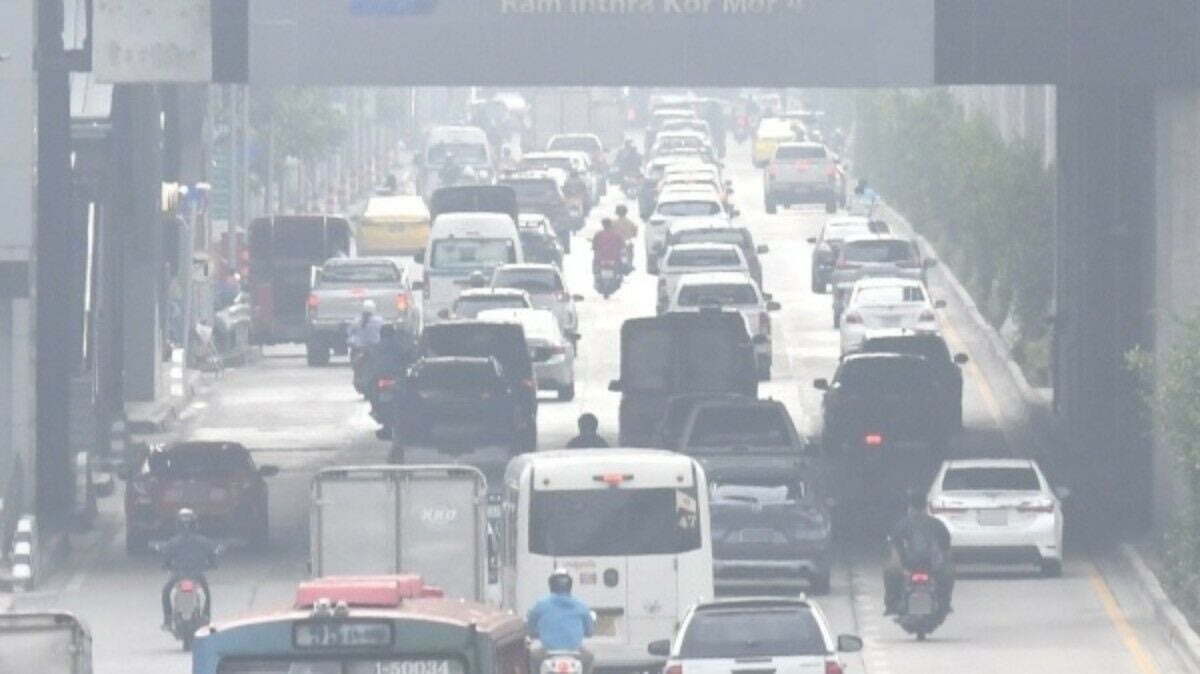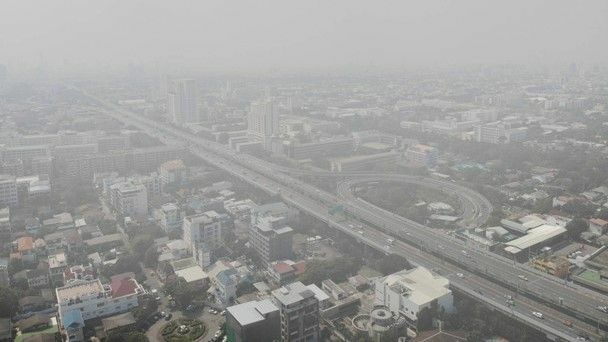Bangkok braces for rising pollution as air quality worsens

Bangkok’s air quality has significantly deteriorated, with 28 areas submerged in PM2.5 dust particles. Officials issued warnings, anticipating a spike in pollution levels between this Sunday, November 17 and next Tuesday, November 19. Residents are advised to take precautions to protect their health.
The Pollution Control Department (PCD) reported on the air quality status in Bangkok and its surrounding areas, based on data from monitoring stations operated jointly with the Bangkok Metropolitan Administration (BMA).
As of 10am today, PM2.5 levels ranged from 20.2 to 63.5 microgrammes per cubic metre, exceeding the standard limit of 37.5 microgrammes per cubic metre in several locations. The Geo-Informatics and Space Technology Development Agency (GISTDA) cautioned that the particulate matter was not mere fog but hazardous pollution.
Among the 28 areas where PM2.5 levels surpassed safety standards are major roads such as Ekachai Road in Bang Bon, Majareon Road in Nong Khaem, and Phet Kasem Road in Phasi Charoen. Other affected zones include Khlong Thawi Watthana in Thawi Watthana, Buddha Monthon 1 Road in Taling Chan, and the vicinity of the Thonburi Railway Depot in Bangkok Noi.
Additional hotspots include the Tha Phra Intersection in Bangkok Yai, Charoen Nakhon Road in Khlong San, and Ratchadapisek-Thapha Road in Thonburi.
Further areas reporting high pollution include Srinagarindra Road in Prawet, Bang Na-Trat Road in Bang Na, Rama III Road in Yannawa, and Narathiwat Road in Bang Rak.
The Odyssey Roundabout on Tri Mit Road in Samphanthawong, Krung Kasem Road in Pom Prap Sattru Phai, and Chalermprakiat 6th Cycle Anniversary Park in Bang Kho Laem have also been affected.
In addition, locations such as Phitsanulok Road in Pathum Wan, Rama II Road in Bang Khun Thian, and various spots in Chom Thong, Din Daeng, and Kanchanaphisek Road have shown elevated pollution levels.
The suburban areas are not spared, with Mahachai in Samut Sakhon, Om Noi in Krathum Baen, and Pak Nam in Samut Prakan exhibiting high PM2.5 concentrations. Other suburban areas such as Khlong Nueng in Khlong Luang, Pathum Thani, and Bang Phut in Pak Kret, Nonthaburi, are also experiencing similar conditions.

Forecasts for the next seven days, from tomorrow, November 16 to 22, indicate a potential increase in pollution levels around November 17 to 19, necessitating continued vigilance. The general public is advised to limit outdoor activities and consider using protective gear. Those with pre-existing health conditions should minimise outdoor exposure and seek medical advice if they experience any health issues.
Residents can monitor the air quality situation via the websites Air4Thai.com and airbkk.com, or through the Air4Thai and AirBKK applications. These platforms provide real-time updates to help the public stay informed and take necessary precautions.
The PCD and other related agencies continue to monitor the situation closely, aiming to mitigate the impact of air pollution on public health. With pollution levels expected to rise, city officials emphasise the importance of staying informed and taking proactive measures to reduce exposure to harmful air, reported KhaoSod.
Frequently Asked Questions
Here are some common questions asked about this news.
Why is PM2.5 pollution particularly hazardous for urban populations?
PM2.5 penetrates deep into the lungs and bloodstream, causing respiratory and cardiovascular issues, especially in dense urban settings with high exposure levels.
How might Bangkok’s geography contribute to its air pollution problems?
Bangkok’s flat terrain and dense urban infrastructure can trap pollutants, reducing air circulation and exacerbating the accumulation of harmful particles.
What if Bangkok implemented stricter emissions regulations—how could this impact air quality?
Stricter emissions regulations could significantly reduce pollutant levels, improving air quality and public health by limiting sources of PM2.5 particles.
How can technology aid in mitigating air pollution in rapidly growing cities like Bangkok?
Technology can optimise traffic flow, monitor emissions, and provide real-time air quality data, aiding in effective pollution management and public awareness.
Why might public awareness and behaviour changes be crucial in addressing air pollution in Bangkok?
Public awareness can drive collective action, reduce pollutant-producing activities, and encourage protective measures, enhancing efforts to improve air quality.
Latest Thailand News
Follow The Thaiger on Google News:


























